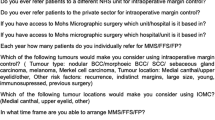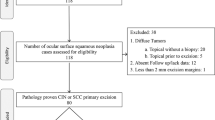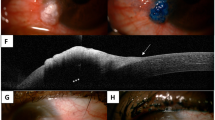Abstract
The Association of Directors of Anatomic and Surgical Pathology developed recommendations for the surgical pathology report for common malignant tumors. The recommendations for tumors of the eye and its adnexa are reported.
Similar content being viewed by others

INTRODUCTION
The Association of Directors of Anatomic and Surgical Pathology named several committees to develop recommendations about the content of the surgical pathology report for common malignant tumors. A committee of persons with special interest and expertise write the recommendations, which are reviewed and approved by the council of Association of Directors of Anatomic and Surgical Pathology and subsequently by the entire membership.
The recommendations have been divided into four major areas: 1) items that provide an informative gross description; 2) additional diagnostics features recommended for inclusion in every report if possible; 3) optional features that may be included in the final report; and 4) a checklist.
The purpose of these recommendations is to provide an informative report for the clinician. The recommendations are intended as suggestions, and adherence to them is completely voluntary. In special circumstances, the recommendations may not be applicable. The recommendations are intended as an educational resource rather than a mandate.
BACKGROUND
Before the public awareness of AIDS and Alzheimer’s disease as health problems, the disease feared most by Americans was cancer; the second most feared condition was blindness (The Gallup Organization, Inc., Public knowledge and attitudes concerning blindness—a survey sponsored by Research to Prevent Blindness, Inc., New York, October 1965 and April 1976, unpublished data). Patients who are confronted with a diagnosis of ocular cancer, therefore, face two of their most principal fears: shortening of their lifespan and loss of vision. Ophthalmologists who manage most patients with ocular malignancies often try to balance the patient’s desire to preserve vision with the goal of eradicating the cancer. In general, the pathologist’s report should catalog not only those features appropriate for estimating the natural history of the patient’s disease (prognosis), but also those features that might compromise vision.
In general, it is recommended that pathologists report on malignancies of the orbit using formats either published or in development for the counterpart lesion elsewhere in the body. For example, lymphomas of the orbit should be reported according to generalized recommendations for reporting lymphomas. It is reasonable for the report for rhabdomyosarcoma (the most common primary malignancy of the orbit in childhood in the United States) to follow recommendations for reporting rhabdomyosarcomas in general. The lacrimal gland may be considered to be a minor salivary gland for the purposes of reporting malignancies in this region, and pathology reports dealing with lacrimal gland malignancies (principally adenoid cystic carcinoma) should follow recommendations for reporting this tumor as described for the salivary gland.
Recommendations are therefore offered for three classes of ocular malignancies: conjunctival neoplasms (including those affecting the limbus—the junction between the cornea and sclera), sebaceous carcinoma (a common malignancy of the eyelid), and the two major intraocular neoplasms (retinoblastoma and malignant melanoma).
-
A. How the specimen was received (e.g., fresh or in fixative)
-
B. How the specimen was identified (e.g., labeled with the name, medical record number, and surgeon’s name)
-
C. Laterality of the lesion (e.g., originating from the right or left eye)
-
D. The exact anatomic location of the tumor
-
1. Conjunctiva: bulbar (by quadrant -superior, inferior, nasal, temporal), palpebral (superior or inferior), fornix (superior or inferior)
-
2. Limbus (by clock hour)
-
3. Caruncle or plica semilunaris
-
4. Eyelid (upper, lower, medial canthus, lateral canthus)
-
5. Intraocular tissue (iris, ciliary body -by clock hour)
-
E. The type of surgical procedure
-
1. Incisional biopsy, excisional biopsy, shave biopsy (conjunctiva, eyelids)
-
2. Iridectomy (removal of iris tissue), iridocyclectomy (removal of iris and ciliary body tissue)
-
3. Enucleation (removal of eye)
-
4. Exenteration (removal of the eye and orbital contents, with or without eyelids, not covered in this report)
-
2. Gross Description
-
A. Conjunctival and Eyelid Biopsy
-
1. Dimensions of the specimen (length, width, thickness)
-
2. Maximum diameter of any visible lesion
-
3. Measurement of minimum distance between edge of lesion and surgical margin (minimum clearance)
-
4. Presence or absence of ulceration
-
5. Color of the lesion and adjacent tissue
-
6. Description of attached tissue (episclera, cornea)
-
7. Orientation of the lesion if provided by the surgeon
-
1. Some surgeons will identify surgical margins of interest by applying a suture to an edge of the specimen, by painting certain margins with dyes, or attaching the specimen to a piece of filter paper and making notations on the specimen mount
-
B. Iridectomy/iridocyclectomy
-
1. Dimensions of the specimen (length, width, thickness)
-
2. Description of tissue received (iris only, iris and ciliary body, iris, ciliary body and peripheral cornea and/or sclera including location by clock hour)
-
3. Dimensions of lesion (length, width, height)
-
4. Measurement of minimum distance between edge of lesion and surgical margin (minimum clearance)
-
1. Relevant surgical margins include the lateral margins and the posterior margin (the anterior margin is the pupillary border and is not a true surgical margin)
-
C. Enucleation
-
1. Dimensions of the eye (anterior-posterior, horizontal, vertical)
-
2. Length of optic nerve attached
-
3. Examination of the surface of the eye for gross evidence of extraocular extension of tumor
-
4. Dimensions of the cornea (horizontal and vertical)
-
5. Clarity of the cornea
-
6. Color of the iris (describe lesions if present)
-
7. Shape and diameter of the pupil
-
8. Transillumination of the eye with dimensions of any shadows
-
1. Transillumination of the eye may be performed with a fiberoptic light source to locate a tumor within the eye by the shadow that it casts during this procedure
-
1. Location of transillumination shadow(s) relative to the limbus and optic nerve (distance of shadow borders from limbus and optic nerve)
-
2. Location of the shadow relative to clock hour
-
9. Describe the section plane used to open the eye
-
10. Obtain cross section of the optic nerve
-
1. Retinoblastoma
-
1. Obtain a section from either the surgical margin of the optic nerve (the transected edge) or the cut surface of the optic nerve as it inserts in the eye
-
1. If the cut section of the optic nerve adjacent to the eye is negative for tumor, then one may conclude that there is no involvement of the nerve posterior to the eye (tumor extends through the nerve without skip lesions)
-
2. Frequently, the surgical margin of the optic nerve (the cut edge of the nerve) is crushed by enucleation scissors
-
11. Describe the cut surface of the eye
-
1. Retinoblastoma
-
1. Number and size of lesions
-
2. Location of the lesion(s)
-
3. Gross evidence of choroidal invasion or extraocular extension
-
4. Presence or absence of vitreous seeding
-
5. Presence or absence of retinal detachment
-
2. Uveal melanoma
-
1. Tissues involved (choroid only, choroid and ciliary body, ciliary body only, iris and ciliary body, iris only)
-
2. Location of the melanoma relative to clock hour
-
3. Dimensions from cut surface (maximum zone of scleral contact, dimension perpendicular to maximum zone of scleral contact, elevation measured from top of lesion to interface with sclera)
-
4. Color of the surface lesion
-
1. Color of the lesion may provide important clinicopathologic correlations to the ophthalmologist
-
1. A white plaque over the surface of the lesion may indicate fibrous metaplasia of the overlying retinal pigment epithelium
-
2. Orange pigment over the surface of the tumor (lipofuscin) is considered by some ophthalmologists as clinical evidence of an aggressive tumor
-
5. Color of the cut surface of the lesion (melanotic, amelanotic, variegated)
-
6. Presence or absence of retinal detachment or hemorrhage
-
7. Presence or absence of extraocular extension or involvement of intrascleral emissary channels
-
3. Microscopic Description
-
A. Conjunctival squamous cell carcinoma
-
1. State presence or absence of invasion into underlying tissues (episclera, corneal stroma)
-
2. State presence or absence of tumor at resection margins, including the deep margin and all lateral margins
-
3. State degree of differentiation (well differentiated, moderately differentiated, poorly differentiated)
-
4. State type (ordinary squamous cell carcinoma, spindle cell variant of squamous cell carcinoma, mucoepidermoid carcinoma)
-
5. Mention presence or absence of vascular, lymphatic, perineural, intraocular, or intraorbital invasion
-
B. Conjunctival malignant melanoma
-
1. State presence or absence of invasion into underlying issues (episclera, corneal stroma)
-
2. State presence or absence of tumor at resection margins, including the deep margin and all lateral margins (description of margins should include presence or absence of intraepithelial primary acquired melanosis with atypia, see note)
-
3. Thickness of the tumor in millimeters and tenths of millimeters as measured by the Jakobiec modification of the Breslow method using a calibrated ocular micrometer. The tumor thickness is measured from the top of the epithelium (there is no granular layer in the normal conjunctival epithelium).
-
1. Some pathologists consider a depth of invasion of 0.8 mm to be significant in separating patients at high risk for metastasis from those at low risk.
-
4. Intralymphatic invasion by tumor
-
5. Optional criteria
-
1. Mitotic figures/mm2; proliferation indices using markers such as MIB-1 or Ki67
-
C. Sebaceous carcinoma of the eyelid
-
1. Location of the tumor (upper eyelid versus lower eyelid)
-
2. Size in millimeters
-
1. Some pathologists consider this measurement to be optional
-
3. Gland of origin (Meibomian versus Zeis gland)
-
4. State presence or absence of infiltrative growth pattern
-
5. Differentiation
-
1. Some pathologists consider the differentiation of sebaceous carcinoma to be an optional feature of the report
-
6. Multicentricity
-
7. Intraepithelial (intraepidermal) pagetoid involvement in conjunctiva, cornea, or eyelid skin
-
8. Tumor involvement of lymphatics or blood vessels or intraorbital invasion
-
9. State presence or absence of tumor at resection margins, including the deep margin and all lateral margins (description of margins should include presence or absence of intraepithelial pagetoid spread)
-
D. Retinoblastoma
-
1. Growth pattern (diffuse, unifocal, multifocal)
-
2. Bilaterality and trilaterality (bilateral with involvement of the pineal gland)
-
3. Differentiation (presence of Flexner-Wintersteiner rosettes, Homer Wright rosettes, and fleurettes)
-
4. Invasion into the optic nerve by layer (prelaminar, laminar, retrolaminar, to optic nerve resection margin)
-
5. Extraocular extension
-
6. Some pathologists and oncologists consider choroidal invasion to be a significant risk factor for metastasis although this feature is not universally accepted as prognostically significant
-
7. Optional features of the tumor
-
A. Endophytic vs. exophytic, presence and degree of tumor necrosis, calcification, DNA deposition around blood vessels, vitreous seeding, anterior chamber seeding (pseudohypopyon)
-
8. Effects of the tumor on the eye
-
A. Retinal detachment; iris neovascularization
-
E. Uveal malignant melanoma
-
1. Location (confined to the iris, involving the iris and ciliary body, confined to the ciliary body, involving the ciliary body and choroid, involving the iris, ciliary body and choroid, or confined to the choroid)
-
2. Extraocular extension
-
3. Growth pattern: diffuse melanoma, ring melanoma, focal melanoma
-
4. Cell type (McLean’s modification of the Callender classification)
-
5. Mitotic figures per 40 high-power fields
-
6. Presence or absence of 100 tumor infiltrating lymphocytes per 20 high-power fields
-
7. Matrix-rich microcirculation-associated loops, networks or parallel with cross-linking structures (some pathologists have suggested that microvascular density is also a prognostic feature)
-
8. Optional features
-
A. Pertaining to the tumor: presence of absence of nevus, necrosis, intrascleral invasion, invasion into the trabecular meshwork, or invasion into the vortex veins; cytomorphometric measurement of nucleolar diameter (mean of the largest nucleoli or standard deviation of nucleolar area), proliferation indices, cytogenetic abnormalities (especially chromosomes 3 and 8)
-
B. Effects of the tumor on the eye: retinal detachment, Bruch’s membrane rupture, retinal invasion, iris neovascularization, angle closure, cataract
Examination of Ocular Tissues
-
1
Torczynski E. Preparation of ocular specimens for histopathologic examination. Ophthalmology 1981;88:1367–71.
-
2
Folberg R, Verdick RE, Weingeist TA, Montague PR. Gross examination of eyes removed for choroidal or ciliary body melanoma. Ophthalmology 1986;93:1643–7.
Conjunctival Squamous Cell Carcinoma and its Variants
-
1
Zimmerman LE. The cancerous, precancerous, and pseudo-cancerous lesions of the cornea and conjunctiva. In: Rycrfot PV 9ed): Corneoplastic Surgery: Proceedings of the Second International Corneoplastic Conference. Oxford: Pergamon Press; 1969:547.
-
2
Cohen BH, Green WR, Iliff NT, Taxy JB, Schwab WT, de la Cruz Z. Spindle cell carcinoma of the conjunctiva. Arch Ophthalmol 1980;98:1809–13
-
3
Rao NA, Font RL. Mucoepidermoid carcinoma of the conjunctiva. Cancer 1976;38:1699–709.
Conjunctival Malignant Melanoma
-
1
Folberg R, McLean IW, Zimmerman LE. Malignant melanoma of the conjunctiva. Hum Pathol 1985;16:126–43.
-
2
Jakobiec FA, Folberg R, Iwamoto T. Clinicopathologic characteristics of premalignant and malignant melanocytic lesions of the conjunctiva. Ophthalmology 1989;96:147–66.
-
3
Seregard S. Conjunctival melanoma. Surv Ophthalmol 1998;42:321–50.
-
4
Folberg R, Jakobiec FA, McLean IW, Zimmerman LA. Is primary acquired melanosis equivalent to melanoma in situ? Mod Pathol 1992;5:2–5.
Sebaceous Carcinoma of the Eyelid
-
1
Rao NA, Hidayat AA, McLean IW, Zimmerman LE. Sebaceous glad carcinoma of the ocular adnexa: a clinicopathologic study of 104 cases with five year follow-up data. Hum Pathol 1982;13:113–22.
Retinoblastoma
-
1
Kopelman JE, McLean IW, Rosenberg SH. Multivariate analysis of risk factors for metastasis in retinoblastoma treated by enucleation. Ophthalmology 1987;94:371–7.
-
2
Messmer EP, Heinrich T, Höpping W, de Sutter E, Havers W, Sauwerwein W. Risk factors for metastases in patients with retinoblastoma. Ophthalmology 1991;98:136–41.
-
3
McLean IW, Rosenberg SH, Messmer EP, et al. Prognostic factors in cases of retinoblastoma: analysis of 974 patients from Germany and the United States treated by enucleation. In: Bornfeld N, Gragoudas ES, Höpping W, et al. (editors): Tumors of the Eye. Proceedings of the International Symposium on Tumors of the Eye. Amsterdam: Kugler Publications;1991:69–72.
-
4
McLean IW, Burnier MN, Zimmerman LE, Jakobiec FA. Tumors of the Eye and Ocular Adnexa. Atlas of Tumor Pathology. 3rd Series, Fascicle 12. Washington, DC: Armed Forces Institute of Pathology, 1994.
Uveal Malignant Melanoma
-
1
Jakobiec FA, Silbert G. Are most iris “melanomas” nevi? Arch Ophthalmol 1981;99:2117–32.
-
2
McLean IW, Foster WD, Zimmerman LE, Gamel JW. Modifications of Callender’s classification of uveal melanoma at the Armed Forces Institute of Pathology. Am J Ophthalmol 1983;96: 502–9.
-
3
de la Cruz JR PO, Specht CS, McLean IW. Lymphocytic infiltration in uveal malignant melanoma. Cancer 1990;65:112–5.
-
4
Folberg R, Rummelt, V, Parys-van Ginderdeuren R, Hwang T, Woolson RF, Pe’er J, Gruman LM. The prognostic value of tumor blood vessel morphology in primary uveal melanoma. Ophthalmology 1993;100:1389–98.
-
5
Sorensen FB, Gamel JW, Jensen OA, Ladekarl M, McCurdy J. Prognostic value of nucleolar size and size pleomorphism in choroidal melanomas. Aprnis 1993;101:358–68.
-
6
Grossniklaus HE, Oakman JH, Cohen C, Calhoun FP Jr, De Rose PB, Drews-Botch B. Histopathology, morphometry, and nuclear DNA content of iris melanocytic lesions. Invest Ophthalmol Vis Sci 1995;1394:745–50.
-
7
Mooy CM, De Jong PTVM. Prognostic parameters in uveal melanoma: a review. Surv Ophthalmol 1996;41:215–28.
-
8
Seregard S, Oskarsson M, Spangberg B. PC-10 as a predictor of prognosis after antigen retrieval in posterior uveal melanoma. Invest Ophthalmol Vis Sci 1996; 37:1451–8.
Author information
Authors and Affiliations
Additional information
The authors were the members of an ad hoc committee of the Association of Directors of Anatomic and Surgical Pathology chaired by Robert Folberg, M.D., Chicago, Illinois.
Note: Ophthalmic pathologists use the term “primary acquired melanosis with atypia” in place of the following terms: intraepithelial atypical melanocytic hyperplasia, malignant melanoma in situ, Level I malignant melanoma.
Rights and permissions
About this article
Cite this article
Folberg, R., Salomao, D., Grossniklaus, H. et al. Recommendations for the Reporting of Tissues Removed as Part of the Surgical Treatment of Common Malignancies of the Eye and its Adnexa. Mod Pathol 16, 725–730 (2003). https://doi.org/10.1097/01.MP.0000076978.06324.EE
Accepted:
Published:
Issue Date:
DOI: https://doi.org/10.1097/01.MP.0000076978.06324.EE


